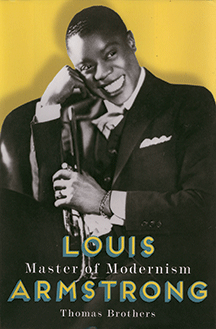
LOUIS ARMSTRONG:
Master of Modernism
By Thomas Brothers C’79
Norton, 2014, $39.95.
You might think that by subtitling his new book about Louis Armstrong Master of Modernism, Thomas Brothers C’79 has put a contemporary scholarly spin on the legendary jazzman long after his career ended. Yet as far back as 1931, Armstrong was being billed as “Master of Modernism and Creator of His Own Song Style.”
“In the 1920s and ’30s, people really loved the idea of being modern,” says Brothers, professor of music at Duke University. “Anything you could call that was a bonus. Technological inventions, the Chrysler Building, radio, and talking movies were all modern, and so was jazz. By modern, they meant something consciously stepping away from Victorian conventions. Jazz, and Armstrong’s innovations in it, was very much front and center.
“Most artists are lucky if they have a single breakthrough period,” he adds. “But Armstrong did it twice. Looking at his career, he’s like Beethoven or Stravinsky or the Beatles in that he moved through different stages and made music that helped define his surroundings.”
Equal parts history and ethnomusicology, Master of Modernism is Brothers’ third book on Armstrong. He editedLouis Armstrong, In His Own Words: Selected Writings (2001) and penned Louis Armstrong’s New Orleans (2007). Both books set the stage for Master of Modernism’s examination of Armstrong’s extraordinary musical breakthroughs following his 1922 emigration from the Crescent City to Chicago.
“His first phase of modernism was for the black community in the mid-to-late 1920s, based on hot trumpet solos that invented a whole new style of playing,” explains Brothers. “The second was for the entire country in the early 1930s, when he started ‘ragging the tune’—taking popular songs and radically transforming them in his own versions.”
By then, Armstrong had become a “modern, sophisticated, Northern, well-paid musician,” and whether he knew it or not, “the task that lay before him was to help his audience understand themselves more deeply by providing them with a musical identity that was black and modern,” Brothers writes.
For all that, Armstrong was hardly immune to the toxic racial atmosphere that befouled his era. Master of Modernism opens with a scene straight out of a movie about the Jim Crow South. In 1931, Armstrong and his band were arrested in Memphis because Armstrong was sitting next to a white woman on a bus—even though she was his manager’s wife. After spending a night in jail, Armstrong and his all-black band played for an all-white audience at the Peabody Hotel, opening with a song Armstrong dedicated to the Memphis Police Department: “I’ll Be Glad When You’re Dead You Rascal You.”
Given that the audience included several members of the Memphis police (who also happened to be members of the Ku Klux Klan), it seems incredible that Armstrong got away without further trouble. Yet the cops later came around to thank Armstrong for the shout-out.
One reason the handcuffs didn’t come out again was that Armstrong sang with a distinctively slurred delivery that made the words difficult to understand. But in Brothers’ telling, a bigger reason was that Armstrong knew what he had to do to get by as an African-American artist during the era of segregation—such as adopting “When It’s Sleepy Time Down South” as his onstage theme song.
“‘When It’s Sleepy Time Down South’ is this highly romanticized vision of Southern happiness where the slaves were content and spent their days singing,” Brothers says. “Armstrong would sing that twice every show, at the beginning and the end, but it was protection for him. He may have been the best trumpet player and most interesting singer in America, but he had no designs on social progress—which should not be surprising. He had a fifth-grade education and grew up under Jim Crow segregation, disenfranchised in a position of political powerlessness. He was not engaged politically very much.”
Nevertheless, Armstrong’s music was so dazzling that it entered the vernacular as an expression of African-American pride during the “Great Migration” to the urban North. For a long stretch of the 1930s, Armstrong’s highly idiosyncratic versions of “Mack the Knife,” “Stardust,” and other standards made him the most popular record-seller in America. But that success came at a cost. Many of Armstrong’s peers branded him the Uncle Tom of jazz, and by the time of his death in 1971, his remarkable innovations were overshadowed by his image as Satchmo, the elder square who sold out with fluffy hits like “Hello, Dolly!” In 1949, Brothers writes, bandleader Dizzy Gillespie dismissed Armstrong as “the plantation character that so many of us … younger men … resent.”
“When bebop came along after Armstrong, it was really presented by younger musicians as a generational revolt,” Brothers says. “The established swing musicians were very critical—especially the ones from New Orleans. But Gillespie, Miles Davis, Charlie Parker, and others had more political awareness and were not willing to put up with what Armstrong’s generation had taken for granted.”
As Brothers points out, Armstrong did push back when and where he felt he could. He refused to play in New Orleans for almost a decade after the city banned integrated bands in the mid-1950s, for example.
“People aren’t used to thinking of music as embedded in the social issues of its time,” Brothers says. “There’s this idea that music ‘transcends’ all that. You know, ‘Why would you want to sully this great music with the filth of racism?’ You see this especially in jazz. There’s been mutual respect across the races for a long time, which is a great thing. But it doesn’t mean racism isn’t part of the story.”
—David Menconi




